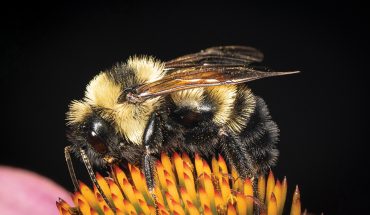by Tony Avent
illustration by Ippy Patterson
I’m not sure why gardeners are so attracted to maidenhair ferns, but odds are the plant’s romantic common name – which aptly describes its dainty foliage – has something to do with it.
Plants from the fern genus, Adiantum, have been cultivated for hundreds of years. First prized as a medicinal diuretic, tumor treatment, and hair tonic, ferns today are a favorite ornamental house plant and hardy garden perennial. I grew up with Northern maidenhair fern, Adiantum pedatum, in my west Raleigh neighborhood, but I wasn’t hopelessly smitten with ferns until some 30 years later, when Rob Gardener, the late N.C. Botanical Garden curator, shared a piece of Southern maidenhair fern, Adiantum capillus-veneris.
As it turned out, the Southern maidenhair fern is endangered in North Carolina, and Rob’s plant had come from a very small population at N.C.’s coastal Lake Waccamaw. As I would soon observe, the North Carolina plant is quite different from the Adiantum capillus-veneris which is commonly sold in the trade – a marginally winter-hardy, poor-growing dud.
In a side-by-side comparison, the North Carolina specimen was amazingly superior both in garden vigor and winter hardiness. I was curious…how could two different plants of the same species perform so differently? My quest for answers had begun.
Soon I discovered our rare N.C. native fern is much more common outside our boundaries. In fact, Southern maidenhair fern is native in 25 of the 50 United States states, even as far away as California. In horticulture, there are few things rarer than the same plant species being native to both North Carolina and California.
The oddest of these native occurrences is a population of Southern maidenhair fern just below South Dakota’s Mount Rushmore, which I had the pleasure of visiting several years ago. There, it grows in a natural hot spring, which allows it to endure the cold South Dakota winters.
This offers no explanation, however, for the multiple populations discovered in the mountains of Southern Colorado, far from the warmth that it seems to require elsewhere.
Several years ago, I spent my Christmas holiday vacation at Arizona’s Desert Botanical Garden herbarium (plant mortuary) looking through their regional collection of deceased specimens of Adiantum capillus-veneris. The diversity was amazing – from typical eight-inch tall plants from southern Arizona, to plants nearly two feet tall from the Grand Canyon. Now, if I can only find time to return when the ground isn’t frozen, as has been the case during my two previous Arizona forays, to find live Southern maidenhair fern.
In subsequent travels, I found Southern maidenhair fern growing wild in Northern Mexican streams, along South African rivers, on the side of buildings in Bermuda, and even in seeping rocks in the dry Mediterranean climate of Crete. Adiantum capillus-veneris likes water, and virtually everywhere it’s found, you’ll also find water nearby.
Other plant explorers have added to my collection with plants from China and France. We also now grow plants from eight of the 25 states where Southern maidenhair fern is native.
In the garden, Southern maidenhair is hard not to love. The seemingly fragile, thin, glossy black, upright stems are adorned with soft green leaves on multiple-branched fronds that just beg to be stroked. The delicate appearance, however, belies its garden toughness. A small start of Southern maidenhair fern will lead to a three-foot-wide patch in 10 years, especially if you keep the soil moisture average and add plenty of good compost to the bed when planting. There’s also no need to worry about providing alkaline soil as long as your soil pH is somewhere between 5.5 and 6.5.
Although fully deciduous most years when the temperature drops below 15 degrees, Adiantum capillus-veneris holds its foliage through most of January, so there are only a few months you won’t enjoy the dainty-looking, deer-resistant foliage.
I hope you’ll add Southern maidenhair fern to your plant love list, whether it’s the tender crested leaf forms that are only suitable as a houseplant, or the myriad of other great forms that add an amazing texture to the outdoor shade garden.




